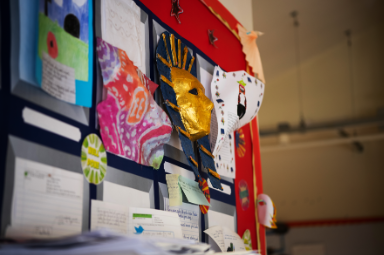.png)
Intent
Stanton Bridge Primary School’s Curriculum Statement of Intent has been constructed to reflect and incorporate each curriculum subject whilst ensuring that each subsequent content designed meets the intent at every opportunity. Thus, the context - past, present and future - are factored in. The past - family influences, social experience and how that may contribute to their new experiences. The present – school and expanding social networks, and how this can positively shape their future given the right environmental and social factors.
Finally, the future - in search of what awaits them in a fast-evolving technological world.

Hence the premise upon which our pupils will grow:
.png) High ambition.
High ambition.
.png) Rich in language with a passion for learning.
Rich in language with a passion for learning.
.png) Habits of Mind that serves to support achievement across all areas of learning.
Habits of Mind that serves to support achievement across all areas of learning.
.png) Strong basis for continuous academic growth beyond their primary years.
Strong basis for continuous academic growth beyond their primary years.
.png) Ability to regulate their social, emotional well-being, with knowledge & skills to tap into a bank of resources that enable them to be flexible in their approach to problem-solving.
Ability to regulate their social, emotional well-being, with knowledge & skills to tap into a bank of resources that enable them to be flexible in their approach to problem-solving.
.png) Stand shoulder to shoulder and thrive with others in a range of different roles, exhibiting leadership qualities and skills.
Stand shoulder to shoulder and thrive with others in a range of different roles, exhibiting leadership qualities and skills.
.png) Acknowledge and appreciate their heritage in world where accepting themselves as individuals and celebrating who they are is key in steering a complex and ever-changing environment.
Acknowledge and appreciate their heritage in world where accepting themselves as individuals and celebrating who they are is key in steering a complex and ever-changing environment.
.png) Having a voice and knowing that they can make a difference to the world in which they live, changing things for the better.
Having a voice and knowing that they can make a difference to the world in which they live, changing things for the better.
.png) Positive relationships and social networks from which they can thrive and excel, seeking and working to include others.
Positive relationships and social networks from which they can thrive and excel, seeking and working to include others.
.png) Belonging to the House of Values, focused on developing character, competence and connectedness. (Relationships, Equality, Care, Thinking Flexibly, and Listening)
Belonging to the House of Values, focused on developing character, competence and connectedness. (Relationships, Equality, Care, Thinking Flexibly, and Listening)
|
Character |
Our pupil are taught to learning with a sense of honesty, coming to know, acknowledge and appreciate both strengths and areas for further growth learning.
They are then taught to respect the learning ahead of them and to appreciate this opportunity to learn where this is not the case for many across the world.
|
|
Competence |
Pupils will have high aspiration for learning, demonstrate confidence in key concepts learned, use subject specific vocabulary, working both independently and interconnected dependent on task set.
|
|
Connectedness |
Pupils will work in harmony with others, within familiar and unfamiliar surroundings. |
Implementation
Introduction
We are a ‘Thinking School’. Our approach to teaching and learning is founded upon the science of learning. We teach our pupils to approach their learning through reflective practice, and use a range of tools to enable them to chart their thinking in a progressive sequential manner. This supports our pupils in becoming self-regulated individuals, working both collaboratively, interdependently as well as independently. Currently, we are under-going a review and assessment process, with the intent of being accredited ‘Thinking School’ by Exeter University.
Pedagogy: The understanding of how concepts are taught.
Pedagogy is the ‘method of teaching’. At Stanton Bridge, we use the Barak Rosenshine’s Principles of Instruction to establish Effective Teaching Practice. This is further strengthened by the use of Thinking Frames that support in the development of Metacognition. Our school’s approach to Teaching and Learning is rooted in the Science of Learning and as such, all staff members are routinely engaged in school improvement activities to develop pedagogy and specific CPD to ensure subject content is expertly delivered. This of course sits alongside individualised mentoring and coaching to support continuous improvements in practice. Responsive coaching also serves to ensure each adult knows the relevant next steps to maximise learning opportunities for all groups of pupils.
